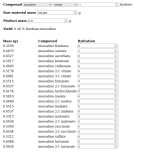Loveall said:
So less water in the paste helped with goo in your case? That's interesting.
Another thing to note is that your cactus is yielding on the lower side (0.3%).
Perhaps lower yielding cacti xtalization is more sensitive to citrate. While Cheelin and I both xtalized additional pulls 6-10 with very low yields, by then other plant matter pulled was low also (we were checking for extraction completenes in pulls 1-5.
Yes, I'm working with a new batch of this powder, so I'm not sure if comparing to my original 0.45% yield is a direct one, time will tell, this might be the best it can do. At the lowest end of moisture with the original powder (2.7:1), I got no extraction at all, so I might not have hit the sweet spot yet.
Definitely notable that I didn't have this problem with the higher yielding cactus (0.66% freebase), the one that turned to rubber at 3:1. The citrate crystallized out of it without using a powerful drying agent like K2CO3.
I'm inclined to believe that water dissolving in the EA is the dominant factor here (along with ambient conditions), and some hydrophilic component (perhaps polysaccharides, which could also explain the textural difference) holds that water back in the paste during extraction. I did an A/B extraction a while back to try to clean up the oil, but I got oil back. That should've excluded the vast majority of other plant material. I wasn't using a proper drying agent for that extraction, only Na2CO3.

 ?
?

